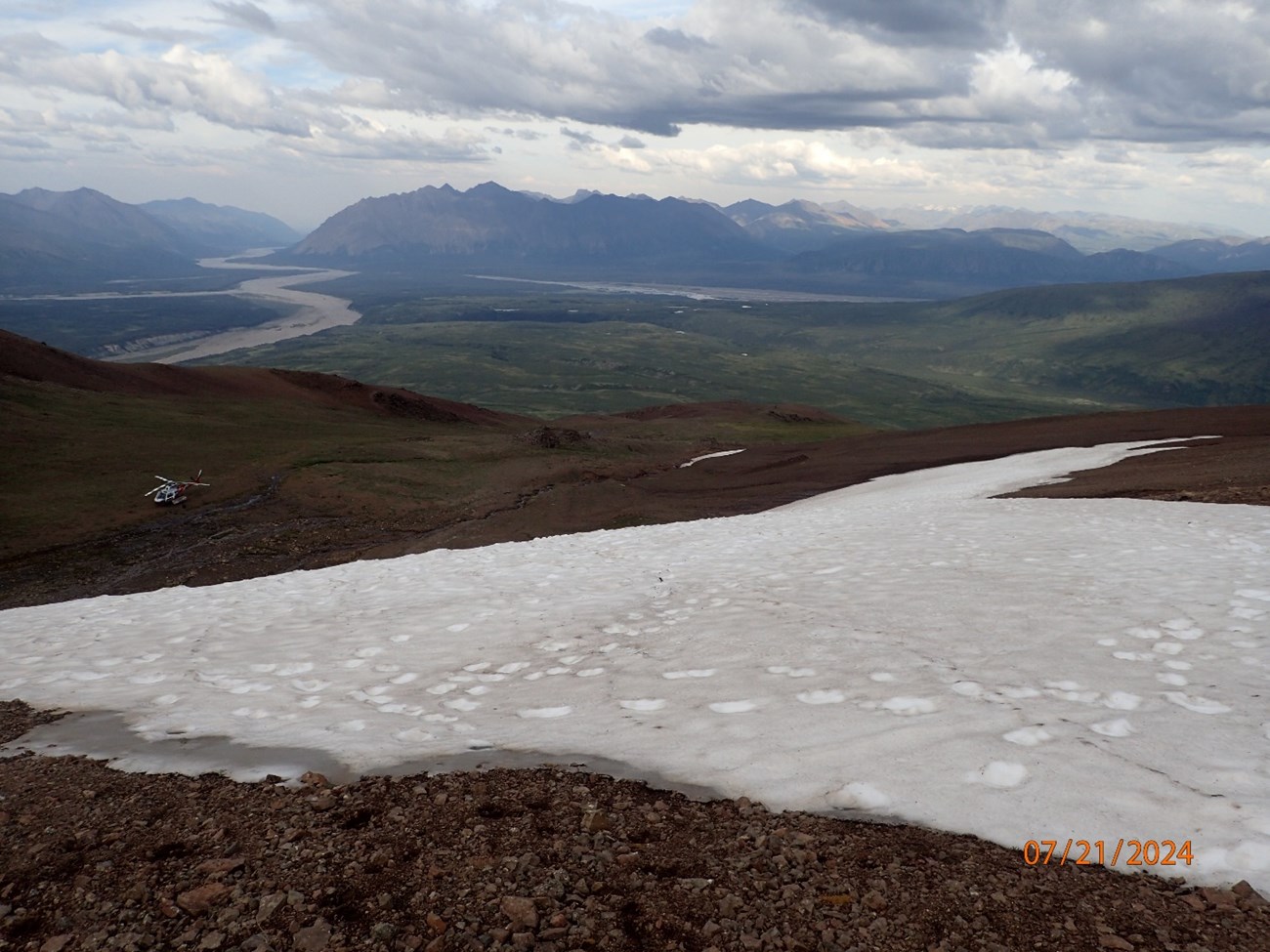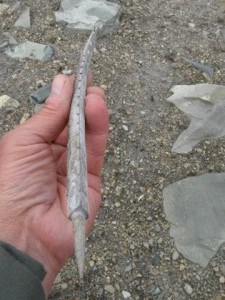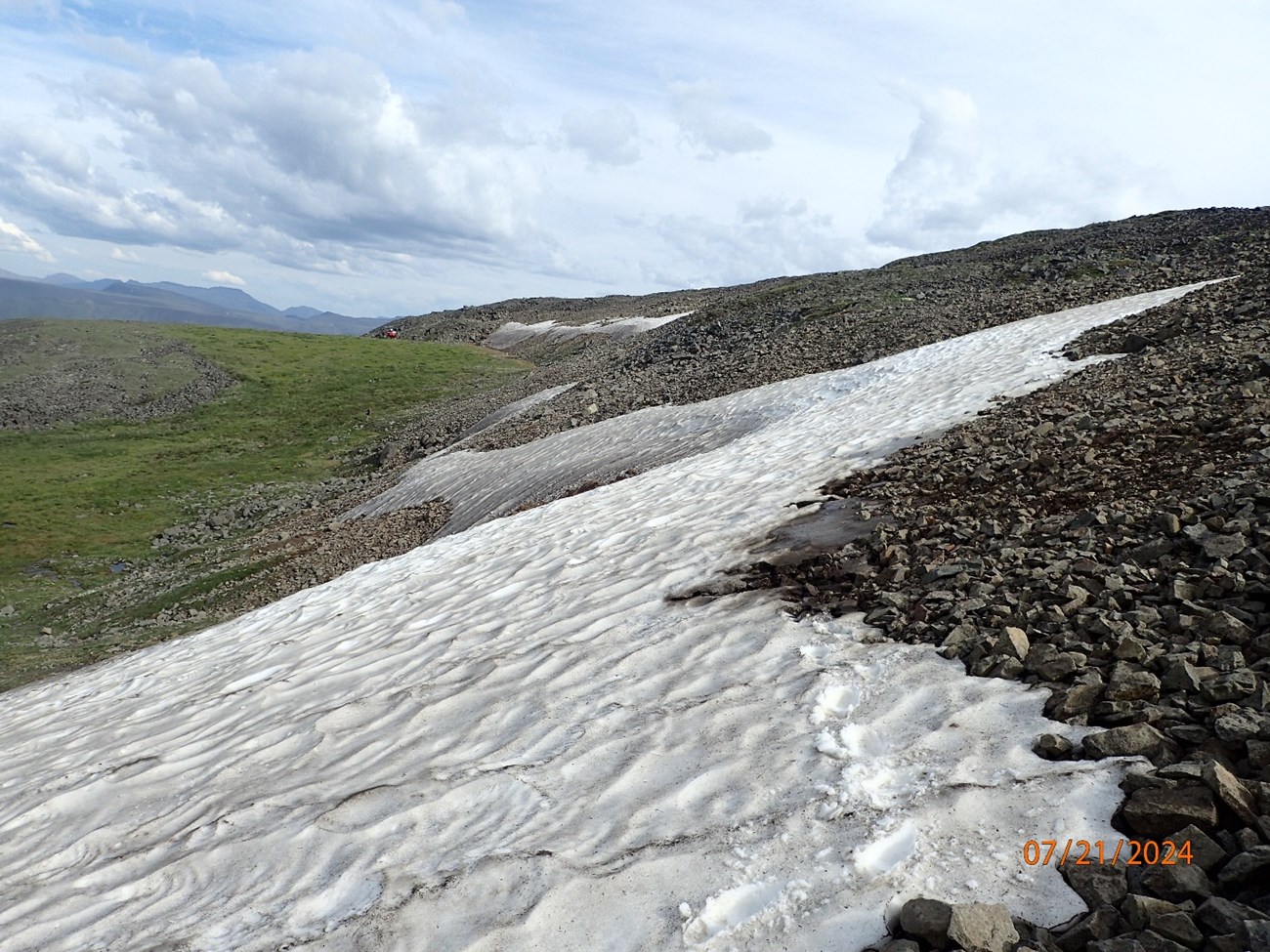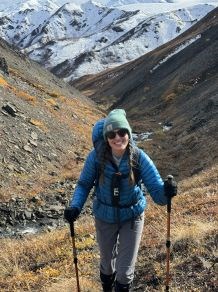Last updated: December 4, 2024
Article
Racing the elements to find artifacts in melting ice patches

NPS Photo
Eyeing rocky, bare ground revealed by a melting ice field, researchers at Wrangell St. Elias National Park and Preserve discovered a birch bark basket. Though it was no longer completely intact, the archeologists could distinctly make out the stitching holes. Preserved in ice, the basket was 650 years old.
The archeologists were searching for artifacts and surveying an area that had once been covered by snow and ice year-round. High in the mountains, snow and ice patches are attractive to wildlife in summer—providing respite from the heat and biting bugs—and similarly attractive to hunters who know to venture to these locations. Early Alaskans may have carried the basket there while on a hunting expedition. Had the basket been left anywhere else in what is now the national park—along one of the gravel river bars, in boggy tundra, or on the forest floor—it wouldn’t have survived long before decomposing.
“In ice, we can find items that would have otherwise disappeared,” said Shina Duvall, Alaska regional archeologist for the National Park Service (NPS).
The frozen landscapes in Alaska can hide thousands of years of information about those who lived on the land before us. As the state warms due to climate change, snow and ice patches are melting and revealing artifacts that have been preserved in excellent condition. But once exposed, the items can immediately begin to degrade. In a race against the elements, archeologists are searching the mountains in Alaska national parks for clues of the past before they are lost forever.
A window into the past

NPS Photo
Ice and snow patches form at high altitudes where cool temperatures keep them frozen year-round. Anything dropped or deliberately left behind by humans or animals—like tools, clothing, fur, or bones—might still be preserved in layers of snow and ice today.
Unlike massive glaciers that are pulled through mountain valleys by gravity, ice patches are stationary, and anything buried within them remains in the place it was deposited. For archeologists, this is invaluable! Knowing where an object was last used provides critical context.
At Lake Clark National Park and Preserve, archeologists found a barbed projectile point near one of Telaquana Mountain’s melting ice patches. Made from antler, the 150-year-old hunting tool was in good condition. On the same mountain, they discovered caribou bones and two other projectiles, dating back nearly 2,000 years. These finds are evidence of hunting traditions that have spanned millennia. Analyzing the tools can shed light on how traditional practices evolved.

NPS Photo
Many artifacts exposed by melting ice patches are inventoried in park museum collections. In labs, scientists can use radiocarbon dating to estimate the age of organic materials or x-ray fluorescence to determine where items made of rock—say an obsidian tool—originated in Alaska. Such information can inform our understanding of the movement of people and trading among groups.
A rare discovery preserved in ice
The birch bark basket in Wrangell-St. Elias National Park was a special discovery. Basketry, clothing, shoes, and other artifacts made from organic materials are unusual to find in Alaska because of the extreme conditions and weather.
“These rare artifacts can share information about domestic activities, which are sometimes less evident in the archeological record,” Duvall said.
What people do in their homes is an important part of the human experience, but this information can be difficult for archeologists to unearth. Wood, fibers, paper, and bones decompose when exposed to the elements, but if they’re buried and frozen in ice and snow patches, these organic artifacts can be preserved for ages. The patches are some of the few places where archeologists can find organic artifacts in Alaska, especially ones in good condition.
The birch bark basket was a sign that someone had ventured into that area long ago.

NPS Photo
Symptom of climate change
Climate change-related warming is occurring in Alaska two to three times faster than the global average. Average temperatures just a few degrees warmer can make a difference, changing snow to rain or causing ice to melt. As a result, many ice patches in the state are shrinking.
While melting provides an opportunity to find well-preserved objects that were previously inaccessible, it also starts the clock on their decomposition. The longer the items sit outside of the ice and are exposed to factors like light, wind, animals, and rain, the more they’ll degrade. If nobody finds the artifact, before long it becomes a missed opportunity.
“There’s also the chance that the artifacts could be buried again by snow,” said Jennifer Pederson Weinberger, NPS cultural resources program manager for the Alaska Region.
The high-elevation locations are dynamic and patches can shrink due to melt, but also grow when there is a lot of precipitation in a year. Artifacts that are re-submerged may never be found or could begin to deteriorate during cycles of freeze and thaw.
Inflation Reduction Act helps expand the search
Hovering in helicopters over steep mountain faces and gentle, snowy slopes, researchers are broadening their hunt for melting ice and snow patches. Archeologists in Alaska national parks have been surveying high priority areas in the mountains for years, but with a boost in funding through the Inflation Reduction Act, now they can expand their search.
“There are many places that need to be looked at, and this money is going to further that work,” Pederson Weinberger said.

NPS Photo
Nearly every national park in Alaska has high-elevation ice and snow patches of interest, so park archeologists are working together to share knowledge and resources. In coordination with Dr. John Blong of Washington State University, park researchers meet monthly to discuss how to support one another. They are exploring opportunities to partner with other federal agencies, state agencies, Tribes, and local communities who have ancestral connections to the lands in question.
“Our hope is that our efforts under the Inflation Reduction Act funding are infused with an ethic of collaboration, including working alongside community and Tribal leaders, elders, and knowledge bearers to inform the priorities of the project,” Duvall said. “We need to take their lead.”
As well as looking for artifacts, the researchers are studying the science of ice patches and learning how to predict changes. Understanding how snow and ice patches fluctuate seasonally and are impacted by changing conditions—like warmer temperatures—will help scientists prepare for different scenarios and identify areas that will likely be threatened in the future.
Critically threatened resources
Cultural resources—from 10,000-year-old artifacts to historical buildings—provide insight into each national park’s story and are pieces of our country’s history. Losing anything is like losing a piece of the puzzle and impacts our ability to see the full picture.
As climate change accelerates in Alaska, finding and saving artifacts exposed by melt in the mountains is just one of many priorities. Cultural resources across the state’s 54 million acres of national parklands are being critically threatened—an archeological site swept away by sudden flooding, a cemetery crumbling as high tides erode an ocean bluff, and the roofs of historical buildings sagging under heavy snow. The Inflation Reduction Act is supporting a variety of projects—including ice patch archeology—to address these risks to cultural resources and help parks prepare for and respond to the changing environment.

Laura Vachula is a writing partner with the National Park Service’s Natural Resource Stewardship & Science Directorate.
Tags
- denali national park & preserve
- katmai national park & preserve
- kenai fjords national park
- lake clark national park & preserve
- wrangell - st elias national park & preserve
- ecosystem restoration
- climate resilience
- inflation reduction act
- bipartisan infrastructure law
- inventory and monitoring
- climate response
- collaboration
- cultural resources
- alaska cultural resources
- alaska
- archeology
- archaeology
- ice patch
